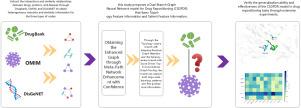Cross-scale semantic fusion integration of dual pathway models in drug repositioning
IF 4.5
2区 医学
Q2 COMPUTER SCIENCE, INTERDISCIPLINARY APPLICATIONS
引用次数: 0
Abstract
Drug Repositioning (DR) represents an innovative drug development strategy that significantly reduces both cost and time by identifying new therapeutic indications for approved drugs. Current methods primarily focus on extracting information from drug–disease networks, but often overlook critical local structural details between nodes. This study introduces CSDPDR, a novel Dual-branch graph neural network that integrates Topology Feature Information and Salient Feature Information to enhance drug repositioning accuracy and efficiency. Through the Topology-aware branch with Adaptive Residual Graph Attention and the Saliency-aware branch with Score-Driven Top-K Convolutional Graph Pooling, the model can capture both large-scale topology patterns and fine-grained local information. Furthermore, our approach effectively alleviate graph sparsity issues through meta-path-based network enhancement and confidence-based filtering mechanisms. Comparative experiments on two benchmark datasets an additional dataset demonstrate that CSDPDR significantly outperforms several state-of-the-art baseline methods. Case studies on Alzheimer’s disease and breast neoplasms further validate the model’s practical applicability and effectiveness.

药物重新定位中双通路模型的跨尺度语义融合整合。
药物重新定位(DR)是一种创新的药物开发策略,通过为已批准的药物确定新的治疗适应症,显著降低成本和时间。目前的方法主要集中于从药物-疾病网络中提取信息,但往往忽略了节点之间关键的局部结构细节。本研究引入了一种新的双分支图神经网络CSDPDR,该网络将拓扑特征信息和显著特征信息相结合,以提高药物重定位的准确性和效率。通过自适应残差图注意的拓扑感知分支和分数驱动的Top-K卷积图池的显著性感知分支,该模型既能捕获大规模的拓扑模式,又能捕获细粒度的局部信息。此外,我们的方法通过基于元路径的网络增强和基于置信度的过滤机制有效地缓解了图稀疏性问题。在两个基准数据集和另一个数据集上的对比实验表明,CSDPDR显著优于几种最先进的基线方法。阿尔茨海默病和乳腺肿瘤的案例研究进一步验证了该模型的实用性和有效性。
本文章由计算机程序翻译,如有差异,请以英文原文为准。
求助全文
约1分钟内获得全文
求助全文
来源期刊

Journal of Biomedical Informatics
医学-计算机:跨学科应用
CiteScore
8.90
自引率
6.70%
发文量
243
审稿时长
32 days
期刊介绍:
The Journal of Biomedical Informatics reflects a commitment to high-quality original research papers, reviews, and commentaries in the area of biomedical informatics methodology. Although we publish articles motivated by applications in the biomedical sciences (for example, clinical medicine, health care, population health, and translational bioinformatics), the journal emphasizes reports of new methodologies and techniques that have general applicability and that form the basis for the evolving science of biomedical informatics. Articles on medical devices; evaluations of implemented systems (including clinical trials of information technologies); or papers that provide insight into a biological process, a specific disease, or treatment options would generally be more suitable for publication in other venues. Papers on applications of signal processing and image analysis are often more suitable for biomedical engineering journals or other informatics journals, although we do publish papers that emphasize the information management and knowledge representation/modeling issues that arise in the storage and use of biological signals and images. System descriptions are welcome if they illustrate and substantiate the underlying methodology that is the principal focus of the report and an effort is made to address the generalizability and/or range of application of that methodology. Note also that, given the international nature of JBI, papers that deal with specific languages other than English, or with country-specific health systems or approaches, are acceptable for JBI only if they offer generalizable lessons that are relevant to the broad JBI readership, regardless of their country, language, culture, or health system.
 求助内容:
求助内容: 应助结果提醒方式:
应助结果提醒方式:


